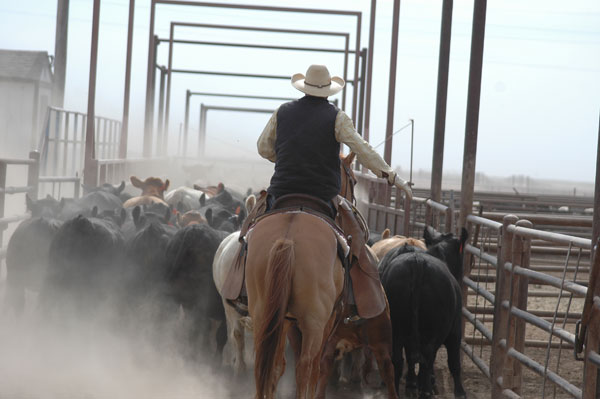Keep your edge when working cattle
Good working conditions help livestock handlers do their jobs safely.
March 22, 2018

Commentary by Bruce Derksen
One morning not so long ago, as Sonny and I were retracing our steps to retrieve a sick steer that escaped us due to the dim morning light, I got to thinking about the ways we hand over control of so many things and inadvertently give an edge to the livestock we work with.
When I was younger, I was an extremely competitive and aggressive person. During my teenage and 20-something years, I played minor and senior hockey and participated in my fair share of scraps and fights. Being young and dumb, someone or something would anger me and I’d lash out, often before I’d even realize who I was about to tangle with. Being of smallish stature, usually it was a much larger opponent who was on the other end of my temper, resulting in me getting my butt kicked on a fairly regular basis.
At the time, I didn’t really care. Then as I got older, I like to think that I got smarter. My temper faded and gradually was replaced by a degree of obsessive-compulsive behavior. I was still competitive and hated giving an edge to anyone or anything if I didn’t have to, but I think I became more intelligent about it.
This behavior carried over into my career and job as well. Nowadays, I don’t like to give cattle an unnecessary edge either. I despise having to go back into a pen of cattle when the sick calf Sonny and I are pulling gets away due to conditions that could be avoided. Livestock are strong and fast enough without any handouts from their human handlers.
Poor infrastructure designs, inferior fencing materials, overcrowding, cramped sorting areas with weak gates, poor lighting conditions, along with decisions that were made hastily or without the proper thought process, can all add to the negative columns of any expense sheet. If fences are constantly requiring repairs due to poor quality materials, costs rise. Poor designs contribute to the need for more labor and repairs as jobs that should be completed in one pass, often require a second or third attempt. When hasty decisions are made to overcrowd pens, the costs can be diminished health and more medical and treatment bills plus excessive labor to complete these treatments.
One example of this usually occurs at the time of year when daylight arrives later in the morning, adding a new challenge to working, sorting and loading cattle for shipment. I’ve worked at feedlots where pen and alley lighting have been unreliable to say the least.
For those of you who have tried to sort cattle in cramped quarters in semi, or even almost total darkness, you know how stressful and dangerous this can be for all involved. Facing down a wild-eyed, snorting, 1,400-pound steer in broad daylight on foot can be a heart pounding experience, never mind when you can hardly see him. It can be downright terrifying as they run toward you at full speed.
Remember the part about not wanting to give an unnecessary edge to the cattle? I’m all for being fair, but I want to survive the day just like everyone else.
And before I come across as picking on the owners of feedlots, ranches or farms as being the only culprits when it comes to cutting corners and giving an unnecessary edge, let me clarify that I believe this applies to everyone involved in the different processes, including us pen checkers. If we cut corners on our horses, tack, feed and even our own personal health and conditioning, we are contributing to the negative side. If I don’t care for Sonny’s feet by using a good farrier, or his health by feeding him good quality feed, we give the edge to the livestock before we even get to our first pen of cattle. If our tack is not kept in good condition and repaired when necessary, we spot that ornery steer an advantage.
The cattle themselves add to the negative side of the sheet by being overly stressed at times from the edges we may offer them, be it by over-crowding which brings more sickness, followed by additional medicines and treatments required, or having to make a second or third trip down the alleyway due to inferior fencing qualities or designs, contributing to weak weight gains. It all adds up in a negative way.
But it’s not only a specific person or group that is to blame. A ranch, feedlot or farm is a group effort between owners, workers and the resources involved on a day-to-day basis. Everyone must pull together and do right by each other or the negative side of the scale will dominate the situation.
Of course, finances and economics can play a large role in everything we do, so common sense must come to the forefront. Design decisions, quality of materials purchased, feed bought, along with all the other decisions, need to be carefully considered with an effort to eliminate as many negatives as possible.
After all, I may not be as rash, hard headed and competitive as I used to be, but that doesn’t mean I am on board with giving an unnecessary edge when I don’t have to. But that’s just me.
Derksen is a freelance writer and feedyard pen rider in Lacombe, Alberta, Canada
You May Also Like


.png?width=300&auto=webp&quality=80&disable=upscale)
